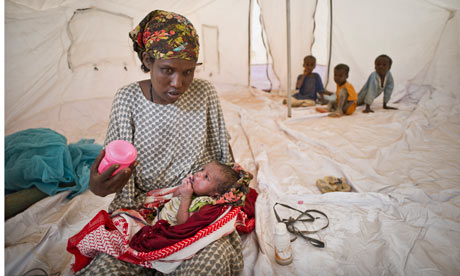Kenyan government refuses to open £10m refugee camp despite growing concern over 400,000 squeezed into Dadaab
Somali refugees in a settlement in Dadaab, Kenya. About 1,400 people fleeing famine and conflict are arriving there every day. Photograph: Sven Torfinn for the Guardian
Somalis fleeing famine and conflict have pushed the population of the world's biggest refugee settlement past 400,000 for the first time, with the host Kenyan government apparently blocking the opening of an already built overspill camp.
About 1,400 Somalis arrive at Dadaab in Kenya's north-east every day, pushing the boundaries of the refugee camps deeper into the arid scrubland, far from toilets, water points and security patrols.
Aid workers are desperate to move some of the most vulnerable people to a new £10m camp called Ifo 2. It was built late last year to house more than 40,000 people and features three schools, four water towers and several hundred latrines.But the Kenyan government has refused to allow the camp to be opened, arguing that it suggests permanence and that the refugees should instead be cared for on Somali soil.
In a compromise arrangement, thousands of Somali families living in makeshift shelters on the outskirts of the three existing camps are being moved into tents on a hastily cleared piece of land called Ifo Extension, where the latrines are still being dug and water has to be trucked in.The impasse over Ifo 2 is causing increasing frustration for aid agencies and the refugees, with the Kenyan government and the UN refugee agency (UNHCR) receiving criticism.
The Kenyan prime minister, Raila Odinga, suggested last month that Ifo 2 could be opened, but the government has not officially confirmed this, and local politicians strongly oppose the move. UNHCR, which described the increasing numbers at Dadaab as "a huge concern", says it has taken Odinga's comments at face value and insists people will soon move into the new camp.
"Ifo 2 is open," William Spindler, spokesman for the agency in Dadaab, said. "We have told NGOs that they can move in."
But a visit to Ifo 2, where refugees were originally supposed to be settled in brick houses, revealed it to be empty. While dozens of tents for refugees were erected there on Wednesday, workers said they had been ordered to stop by the local authorities. Shelterbox, the charity that donated the tents, said on Thursday that work had resumed.
The situation is likely to become ever more urgent because the flow of Somalis across the border is expected to continue in the coming months. Famine conditions already exist in several parts of southern Somalia, and aid is arriving slowly because of logistical challenges and restrictions imposed by the al-Shabab insurgents who control some of the worst-hit areas. Many of the refugees are arriving in poor shape, with many children suffering from malnutrition.
The three Dabaab camps – Dagahaley, Ifo and Hagadera – were originally set up 20 years ago when Somalis first started fleeing drought and war. They were designed for 90,000 people, but the population quickly swelled past that as Somalia descended into a failed state.
Kenya has historically been a generous host to refugees from neighbouring countries. But in recent years the government has become concerned by the situation in Somalia, particularly the terror threat posed by al-Qaida-affiliated insurgents.The flood of Somali refugees – more than 130,000 Somalis have reached Dadaab this year, about 85,000 of them since June – has also raised concern about the environment. In 1991, water could be found 10 metres below the surface. Now boreholes in Dabaab must be drilled 200 metres underground. Tree cover has been drastically reduced by the need for firewood.
Besides the 400,579 refugees that were officially recorded in Dadaab by Monday, a further 38,000 were waiting to be registered. This means Dadaab is the third-biggest "city" in Kenya. If the current flow continues, the official camp population will exceed half a million people by late October.
In a statement on Tuesday, the Kenyan president, Mwai Kibaki, reiterated the message that the status quo was unacceptable. "Somali refugees need to be settled inside their country and be given food and other forms of support they may require while there," he said.
Politicians in north-east Kenya are even more vehement that the influx of Somalis must end. They say the refugees receive much better services than the local population, who have also been affected by the drought and historic underdevelopment.
The one-room brick houses built by aid agencies for refugees in Ifo 2 have been a particular source of resentment, mainly because they are seen as better than the homes of millions of Kenyans. Only 116 out of the planned 15,000 houses were built before the government ordered the project halted last December. Kenyan officials are also concerned that building permanent structures would make the refugees reluctant to go home.
UNHCR says it has settled 14,000 people in tents on the 10-metre by 12-metre plots in Ifo Extension over the past few weeks, and plans to move 90,000 more there from the edges of the existing camps. By November, it hopes to have moved a further 90,000 people to a new settlement called Kambi Os, near the Hagadera camp. The government has yet to approve this.

No hay comentarios:
Publicar un comentario